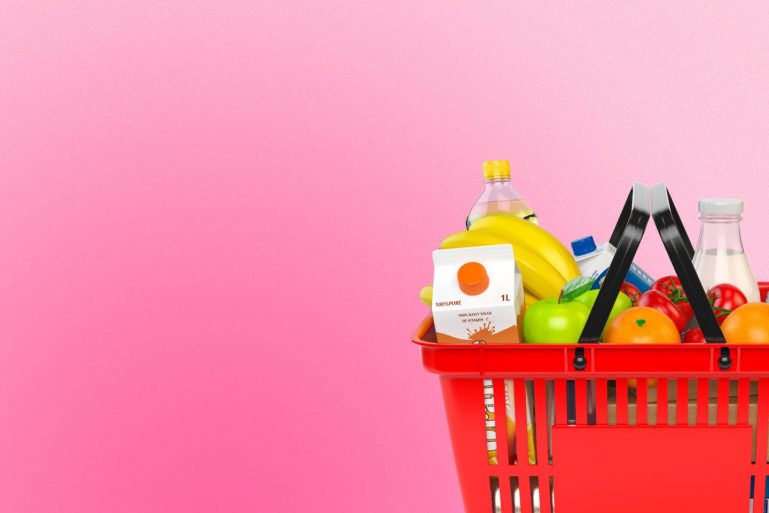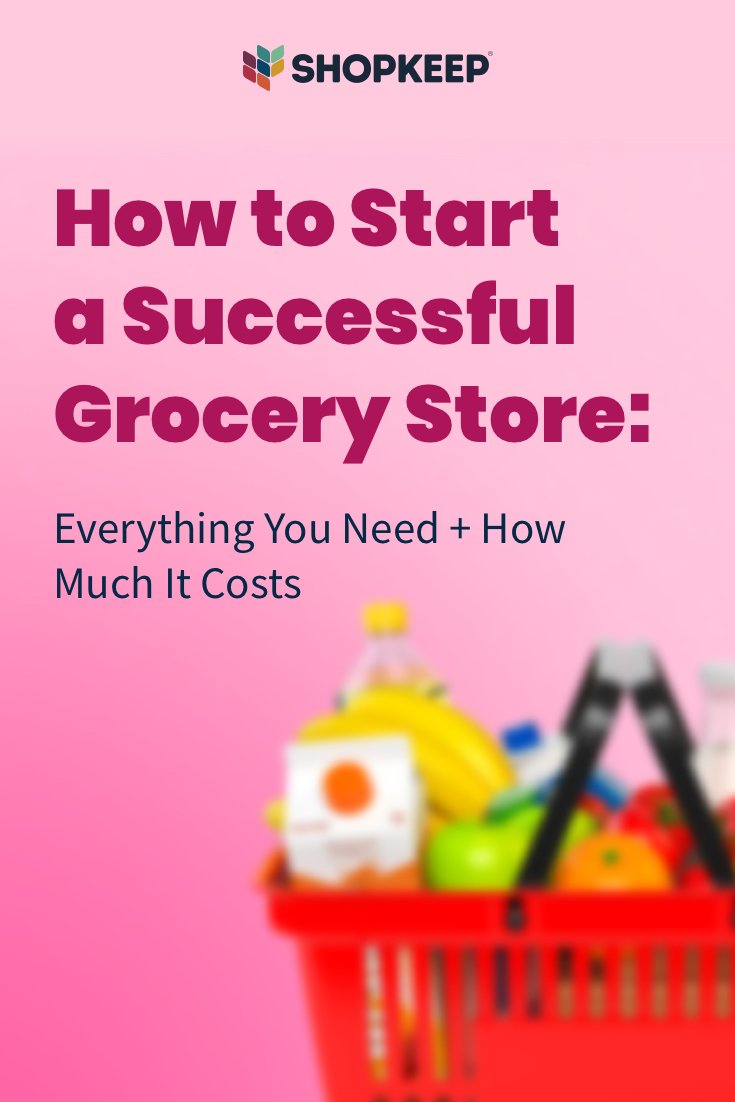
The True Cost of Opening a Grocery Store
If you’re looking to open an essential business, a grocery store is a solid choice.
Since the onset of the global pandemic, online and in-store grocery sales have soared. The proof? Grocery store businesses who use ShopKeep point of sale saw online sales go up by 1,600% and in-store sales increase by 5% year over year from August 2019 to August 2020.
While these trends are both promising and encouraging, opening a grocery store requires a sizable upfront investment. You’ll need to pay for specialized licenses, equipment, software, and more. To help you avoid sticker shock before you officially go into business, we’ve broken down the major costs of starting a grocery store.
Costs to Consider When Starting a Grocery Store
- Choosing Your Location
- Getting Licensing, Permits, and Insurance
- Hiring and Managing Staff
- Purchasing Inventory
- Purchasing Tools and Equipment
1. Choosing Your Location
When finding space for your grocery store, you have three options:
1. You can rent an existing storefront.
2. You can buy an existing storefront.
3. You can build your own storefront.
When it comes to finding a space to rent, bigger doesn’t mean better. In fact, many top-rated grocery chains like Aldi and Trader Joe’s are only 12,000 square feet, compared to the 50,000 to 140,000 spaces that house the likes of Stop & Shop and Wegmans. The average cost per square foot for retail real estate rentals is constantly changing and depends heavily on your location. To give you a sense of how much rent would cost, a 12,000 square foot store with an annual rate of $15 per square foot would cost $15,000 per month to rent: ($12,000 x $15)/12 = $15,000.
Just like with renting, the price of buying a storefront depends mainly on its location. Commercial real estate in New York City, for example, can run in the millions. Similar properties in rural Idaho are about $500,000. If you’re not sure whether renting or buying would make more financial sense, you can use a rent vs. buy calculator to find out.
Building your own store can cost significantly more than buying or renting, and it takes much longer. The average cost per square foot to build commercial property is $56 per square foot. For a 12,000 square foot store, that comes out to about $672,000. You’ll also need to pay for an architect to design the store ($3,000 on average), a contractor (10-20% of the total cost of your project), as well as permit and inspection fees ($550 on average).
2. Getting Licensing, Permits, and Insurance
To operate a food business, you’ll need proper licensing. The exact type of license you’ll need depends on where your store is located. Browse your state government’s website to find more detailed information on the exact food or retail business license you may need.
You’ll also need an additional license if you plan to stock alcohol. The cost for an off-premise liquor license ranges from $300 to $14,000 depending on your state. We recommend getting all of your required licenses at least 2 months before your scheduled opening date to allow enough time for processing.
As for insurance, most businesses are covered by general liability insurance, which protects your business from common lawsuits. Most small business owners pay between $300 and $600 annually.
3. Hiring and Managing Staff
Running a grocery store of any size is definitely more than a one-person job. You’ll need to find the right staff to ring up customers at the register and keep your store clean. Here is an overview of the typical positions found in a grocery store and the average salaries for each:
Bagger: $7.25-$9.00 per hour
Cashier: $7.25-$9.00 per hour
Custodial Staff: $8.00-$10.00 per hour
Department Manager: $14.00-$16.00 per hour
Assistant Store Manager: $16.00-$18.00 per hour
Store Manager: $20.00 per hour
The staff you’ll need to hire depends on how you plan to operate. Will you have more than one register open during a shift? You’ll need more than one cashier. Will you have specialized departments like a bakery, deli, or seafood department? You’ll need staff to run and manage those departments. Our advice is to be as realistic as possible— don’t hire anyone you don’t need, but make sure you have all of your bases covered for your busiest hours. Try to pay your employees on the higher end if possible — remember, they’re essential workers and deserve to be compensated appropriately.
Posting an online job ad isn’t always free, either. Depending on the job website, posting a single job ad can cost you anywhere from $0.10 per click to $249 per month. To save on advertising costs, we suggest posting open roles to your social media accounts and reaching out to your personal networks to spread the word.
Once you’ve hired your first employee, it’s a good idea to keep track of how they do on the job with employee management tools on your POS system. You’ll be able to keep track of when they clock in and out of their shifts, as well as see their sales performance. You can use automated data to track who your best employees are and schedule them at busiest times to increase your profits.
4. Purchasing Inventory
Your inventory costs will mostly depend on two things:
1. How many products you sell. A small convenience store might sell as few as 500 items, or SKUs, whereas a medium-sized store might sell up to 2,500 items.
2. The types of products you sell. Some types of items are more expensive to stock than others. Prepackaged goods like snacks and candy bars, for example, are pretty inexpensive to stock, but specialty items and premium brands will cost more.
Regardless of the size of your store, you should expect to pay at least $20,000 in initial inventory costs.
With such a large amount of inventory, it’s important to invest in a powerful inventory management tool to make your life easier and ensure you’re investing in the most profitable products. A POS system with built-in inventory management controls makes it easy to track what’s selling, what’s not, and keep an accurate count of what’s in stock.
SEE ALSO: How to Keep Track of Inventory For First-Time Business Owners
5. Purchasing Tools and Equipment
While rent, labor, and inventory will be ongoing expenses, most of the tools and equipment you’ll need will be upfront purchases. It’s a smart idea to invest in high quality tools from the very beginning to avoid getting stuck with faulty equipment down the line. For certain items, like shopping carts or POS hardware, you can save on costs by buying them used instead of new. We’ve listed the most important tools you’ll need with estimates for how much they’ll cost.
Store Shelving: $200 to $1,300 each
The more aisles you have, the more shelving you’ll need. Shelving units typically range from $200 to $1,300 a piece, depending on their height, width, and material. Most retail shelving companies will give you a personalized quote based on your needs.
Aisle Signage: $100 to $500 each
Aisle signs make it easier for both customers and employees to navigate through your store. You’ll find basic designs for a lower price and more elaborate designs on the higher end of the spectrum. We recommend choosing signage that’s both easy to read and accurately reflects your store’s brand identity.
Shopping Baskets and Carts: $6 to $90 each
A typical Walmart Supercenter has as many as 600 shopping carts on hand, but chances are you’ll need less than 150 for a smaller store. If you’re short on parking space for full-size shopping carts, mini carts or shopping baskets are great alternatives.
Refrigerated and Frozen Merchandisers: $1,800 to $10,000 each
If you plan to sell any refrigerated or frozen products, you’ll need special merchandisers to keep your products nice and cool. Like shelving, the price of each merchandiser depends mainly on size. Larger ones have larger price tags.
Storage Coolers: $300 to $10,000 each
Storage coolers keep your inventory at the right temps before it’s put out for display. Coolers come in various shapes and sizes, from mini to walk-in.
Screen Guards and Cleaning Supplies: $400+
Now more than ever, it’s important to keep your store clean and protect your employees and customers from getting sick. Make sure you regularly wipe down all surfaces with wipes, soap, water, and bleach (when safe) and provide your employees with proper PPE like gloves and masks. By installing screen guards at your checkout area and providing hand sanitizer at the most contact-heavy areas, you’ll help stop the spread of novel viruses and the common cold alike.
Grocery Store POS System: $49 to $179 per month
A modern, cloud-based POS is a must for 2020 and beyond. Not only will a POS allow you to process transactions with all major payment types (credit card, debit card, cash, NFC, etc.), but you also get access to advanced reporting, inventory management tools, and employee management capabilities that can help you grow sales and run your business more efficiently. For a store with thousands of SKUs, having a POS with a built-in inventory management system is essential for staying organized.
Payment Processing: Depends on Processor
In order to take credit card payments at your register, you’ll need to sign up for a payment processor. Payment processors take a small fee or percentage of each credit card sale, so it’s in your best interest to find a processor that saves you money in the long run. Those small fees add up over time and have a major impact on your business. We recommend choosing a processor with a flat fee that accepts all major credit cards, debit cards, as well as contactless methods like Apple Pay and online invoicing.
Website: Included in some POS plans
In today’s world, a digital presence is a necessity. There are dozens of eCommerce platforms out there, and some are designed specifically to help grocery stores ship products and offer in-store pickup for online orders. Platforms like ShopKeep eCommerce make it easy to build a fully-functional, well-designed online store, even if you’re not tech savvy. By choosing an eCommerce platform that integrates with your point-of-sale register, your inventory will be synced across online and in-store transactions. This makes it easy to offer local deliveries and curbside pickup.
SEE ALSO: Payment Processing 101: Interchange Plus Rates vs. Flat Rates
The Bottom Line
Starting a grocery store isn’t exactly cheap, but they’ve proven to be one of the most resilient types of businesses you can open in today’s retail environment. While it might seem hard to compete with bigger brands like Kroger or Walmart, starting a specialty grocery store might be the key to standing out from the competition in your local area. Whatever type of grocery store you decide to start, it’s important to invest in the right tools from the very beginning. With smarter, powerful tools that work together, you’ll be able to make smarter decisions to grow your business.
Want to try ShopKeep for yourself?
Just answer a few easy questions.
Need help finding the right point of sale?
Just complete the form. We’ll call you right back to explain how ShopKeep can work for you.
Hit the ground running.Sprinting, in fact!
Read our free, comprehensive guide, Small Business 101, to learn all you need to know about starting a thriving business.


